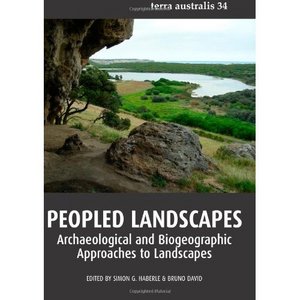Regional genetic differentiation in the spectacled flying fox (Pteropus conspicillatus Gould)
Fox, Samantha, Waycott, Michelle, Blair, David, and Luly, Jon (2012) Regional genetic differentiation in the spectacled flying fox (Pteropus conspicillatus Gould). In: Haberle, Simon G/, and David, Bruno, (eds.) Peopled Landscapes: archaeological and biogeographic approaches to landscapes. Terra Australia, 34 . ANU E Press, Canberra, ACT, Australia, pp. 459-472.
![[img]](https://researchonline.jcu.edu.au/19684/2.hassmallThumbnailVersion/19684_Fox_et_al_2012_Cover.jpg)
|
Image (JPEG) (Book Cover)
- Cover Image
Download (48kB) |
|
|
PDF (Published Version)
- Published Version
Restricted to Repository staff only |
Abstract
[Extract] Climatic excursions in the late Pleistocene dramatically reduced habitat available to organisms dependent on forested landscapes (Hopkins et al. 1993; Kershaw 1994; Kershaw et al. 2007; VanDerWal et al. 2009). Pollen analysis and bioclimatic modelling of rainforest in northeastern Queensland indicate the region was subject to massive change during Quaternary glaciations. The consequences for rainforest-dependent species were severe, especially for organisms with limited mobility or adaptability (Schneider et al. 1998). We report here on present-day regional-scale genetic structure in the spectacled flying fox (Pteropus conspicillatus), generally assumed to be a rainforest specialist, and on the insights modern-day processes may provide for understanding responses of an extremely mobile animal to Pleistocene habitat contraction and fragmentation.
All flying foxes are potentially extremely mobile and some species make seasonal migrations across hundreds of kilometres, following cycles of fruiting and flowering of favoured food trees (Eby 1991; Tidemann and Nelson 2004). Species such as the little red flying fox (Pteropus scapulatus) and grey-headed flying fox (P. poliocephalus) traverse many hundreds of kilometres in the course of a year and are apparently panmictic (Sinclair et al. 1996; Webb and Tidemann 1996: Luly et al. 2010). In contrast, the spectacled flying fox is considered to be closely associated with rainforest (Richards 1990a, b) and currently has a discontinuous distribution in northeastern Queensland, New Guinea and adjacent islands. By far the largest known populations are associated with coastal and upland rainforest in the Wet Tropics World Heritage Area (hereafter the Wet Tropics) between about Townsville and Cooktown in northeast Queensland (Westcott et al. 2001). A small colony – a few hundred strong at most (Fox 2006) – is found approximately 400 km north of the Wet Tropics in the Iron Range National Park on Cape York Peninsula, where isolated pockets of wet tropical rainforest provide habitat. The species occurs widely and patchily outside Australia (Figure 1), but little is known about population sizes. It is found in the Molucca Islands in Indonesia, in lowland New Guinea from approximately Agats in Irian Jaya, around the north coast to the Port Moresby district in the east and offshore in the D’Entrecasteaux Islands and the Louisiade Archipelago. There is a break in the range on the drier southern coast of New Guinea closest to the tip of Cape York Peninsula (Bonaccorso 1998). The New Guinea distribution is, at its closest, approximately 600 km from the northernmost permanent Australian colony at Iron Range. Radio telemetry and satellite tracking have shown that individual spectacled flying foxes in the Wet Tropics region undertake regular movements between colonies (Shilton pers. comm.). It is not known whether any movement occurs between the Wet Tropics, Iron Range (IR) and Papua New Guinea (PNG), or what movements occur within New Guinea and Indonesia.
Given the assumed habitat specialisation of the spectacled flying fox, the species might be expected to exhibit stronger genetic differentiation across its disjunct range than apparently less specialised congeners. Examining the extent of differentiation, if any, in the modern range of the spectacled flying fox may help inform thinking on the capacity of flying fox species to maintain genetic integrity in the even more severely fragmented habitats that prevailed during glacial episodes. To investigate this, we set out to determine the extent of gene flow between colonies in the Wet Tropics, and between the Wet Tropics as a whole and other regions (IR,PNG) where spectacled flying fox populations occur.
| Item ID: | 19684 |
|---|---|
| Item Type: | Book Chapter (Research - B1) |
| ISBN: | 978-1-921862-71-7 |
| Date Deposited: | 25 Jun 2012 05:47 |
| FoR Codes: | 06 BIOLOGICAL SCIENCES > 0604 Genetics > 060411 Population, Ecological and Evolutionary Genetics @ 100% |
| SEO Codes: | 96 ENVIRONMENT > 9699 Other Environment > 969999 Environment not elsewhere classified @ 100% |
| Downloads: |
Total: 530 Last 12 Months: 5 |
| More Statistics |



